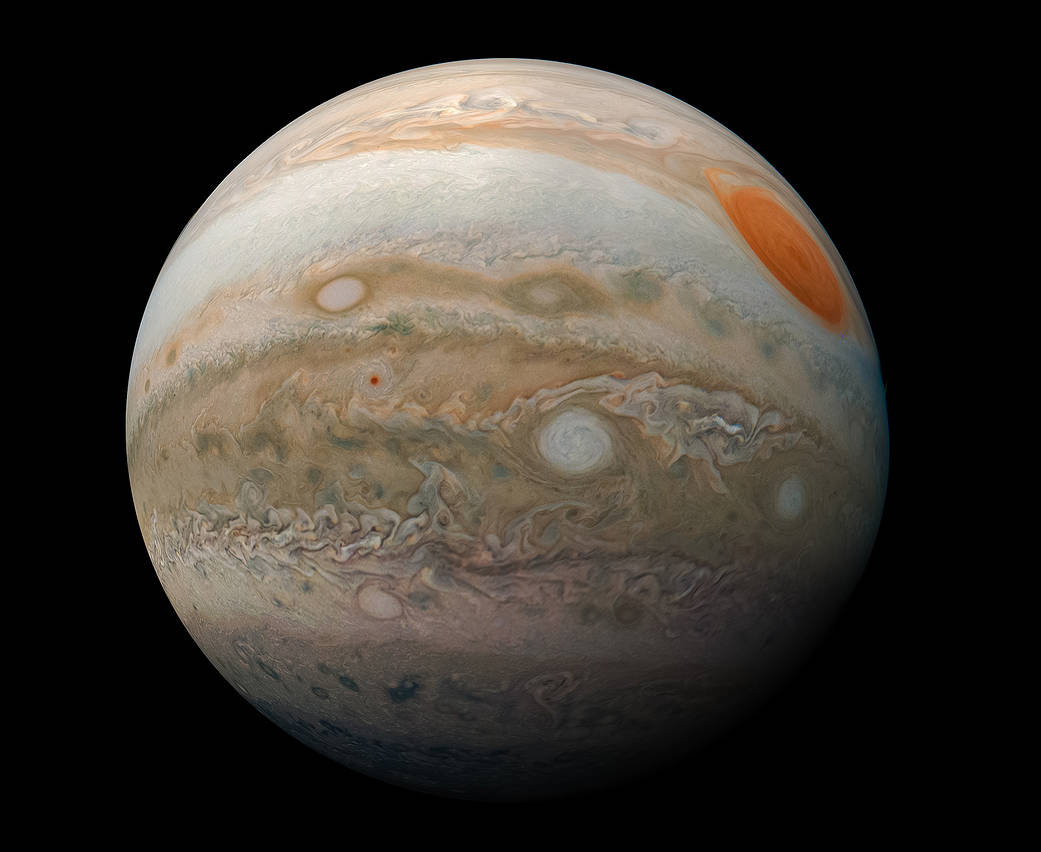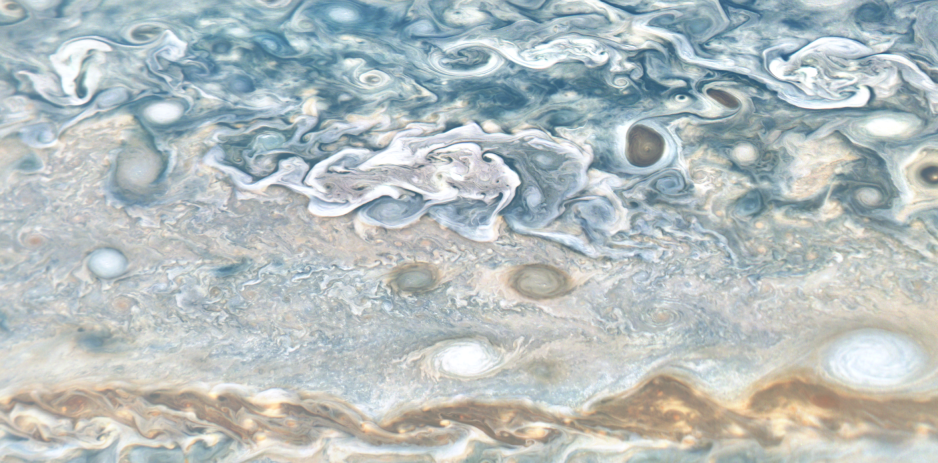What Would The Planet Jupiter Taste Like?

Header Image: Color enhanced image of Jupiter’s southern hemisphere, taken on February 12, 2019 by NASA’s Juno spacecraft. Image Credits: NASA/JPL-Caltech/SwRI/MSSS/Kevin M. Gill
Written by Dr. Geza Gyuk, the Adler Planetarium’s Senior Director of Astronomy and Bella Mutert, the Adler Planetarium’s Digital Marketing Specialist
Have you ever found yourself wondering, “what would Jupiter taste like?” No? Just us?
Well…regardless of your planetary palate ponderings, Dr. Geza Gyuk—the Director of Astronomy at the Adler Planetarium—compiled some information on the taste and smell of our friendly neighborhood gas giant. We are here to report: it’s not what we expected.
Jupiter’s atmosphere is composed of a variety of chemicals and compounds, but the most abundant are molecular hydrogen (H2), and helium, He. Both of these compounds are odorless and tasteless.
The third most abundant compound is methane, CH4, another tasteless and odorless gas. Because methane is a main component of the natural gas that we use in day-to-day life, utilities add a smelly chemical that reminds us we accidentally left the stove on. The naturally occurring chemical however, like the compound found in Jupiter’s atmosphere, is odorless.
With all flavorless compounds making up Jupiter’s big three, we’re off to a strong start. But what about the stinkier, more flavorful elements in Jupiter’s atmosphere?
Ammonia, NH3, has a concentration of 700 parts per million (ppm) in Jupiter’s atmosphere. It’s detectable by humans at 5 ppm, and “highly penetrating” at 50 ppm. So it’s safe to say that the NH3 in Jupiter’s air would be very dangerous and especially irritating to your lungs and eyes. The worst part? Ammonia is described as smelling like urine and/or sweat.
Next up is hydrogen sulfide, H2S. H2S is a highly toxic gas with a classic rotten egg smell. It occurs in Jupiter’s gaseous atmosphere at 77 ppm. It is detectable to humans at 0.5 ppm, becomes offensive at about 4 ppm, and described as “sickeningly sweet” above 30 ppm. Therefore, Jupiter’s levels of H2S would definitely be categorized as very offensively sickeningly sweet.
Much higher levels of H2S (1000 ppm) can cause nearly instantaneous death. But even levels of 100 ppm can cause death in just 48 hours. At 77 ppm, you’d probably be safe, especially for a few breaths just to sniff the atmosphere, making this galactic taste test theoretically feasible.
Phosphine, PH3, another toxic gas, can be found in Jupiter’s atmosphere around levels of 0.5 ppm. Its abundance on Jupiter falls below the detection threshold of 2 ppm—this is good news for us as PH3 is known to have an odor reminiscent of garlic or rotten fish. While you probably wouldn’t notice the scent on Jupiter, the OSHA limit is 0.3 ppm, so it would still be bad to breathe in over an extended period of time.
Similarly, arsine, AsH3, appears in Jupiter’s atmosphere and also has a “disagreeable garlic” smell, but luckily for us, it occurs at levels more than 1000 times too low to smell.
Now that we’ve sniffed our way through Jupiter’s atmosphere, you may be wondering, “what about the clouds?” Well, the high clouds are probably crystals of frozen ammonia, and the lower, more colorful clouds are likely the toxic ammonium hydrosulfide, but information about its taste is hard to come by.
No one knows exactly why Jupiter’s clouds are so colorful. It is believed to be due to sulfur compounds in the clouds, and possibly complex organic compounds in the Great Red Spot. But again, since we don’t know exactly what they are made of, it is hard to say what the smell and taste would be.
We’ve concentrated on smell because Jupiter is a gas giant and the atmosphere is something you could directly smell. We also know that taste and smell are closely related senses. At the right altitude, temperature and pressure aren’t crazy, so it’s relatively feasible to imagine!
So, if you were an astronaut sent on a mission to the clouds of Jupiter, with a leak in your protective suit, Jupiter would probably taste and smell like a pungent mixture of sweaty urine and sickeningly sweet rotten eggs. Bon appetit!
Curious about what the Sun would taste like? Watch here.
Help NASA Understand Jupiter’s Clouds

You can help researchers catalog interesting cloud features in Jupiter’s atmosphere! Through Adler Zooniverse—the world’s largest and most popular platform for people-powered research, aka citizen science—you’ll look at JunoCam images that will aid scientists in determining the underlying fluid dynamics that leads to the formation of vortices and turbulent structures on Jupiter.
You don’t need any specialized background, training, or expertise to participate in Zooniverse projects and finding a project you’re passionate about helping is easy. Just ask the other 2.4 million Zooniverse citizen scientists! All you need to contribute to real academic research is a curious mind, a willingness to learn, and a computer or phone. Researchers need volunteers (that’s you) to assist in processing large sets of data for projects across a variety of different topics like art, biology, climate, history, language, literature, medicine, nature, physics, social science, and space.






